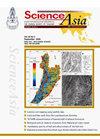联合抗菌素治疗会引发铜绿假单胞菌c的蛋白质组学变化。白色念珠菌多物种生物膜
IF 0.6
4区 综合性期刊
Q3 MULTIDISCIPLINARY SCIENCES
引用次数: 3
摘要
铜绿假单胞菌已知在多物种生物膜中与白色念珠菌共存并相互作用。在我们之前的工作中,联合抗菌药物治疗已被证明可以显著抑制这种多物种生物膜;然而,与这种生物膜抑制相关的蛋白质组学变化仍未得到很好的理解。因此,本研究旨在确定铜绿假单胞菌c的蛋白质组谱。联合抗菌剂治疗后白色念珠菌多物种生物膜。铜绿假单胞菌。白念珠菌多菌种生物膜在6孔微孔板上培养,在37℃好氧和厌氧条件下培养24 h。用40 mg/ml联合抗菌剂(红霉素20 mg/ml:制霉菌素20 mg/ml)处理后,采用二维聚丙烯酰胺凝胶电泳(2D SDSPAGE)和质谱联用分析多物种生物膜的全细胞蛋白质组。另一方面,使用STRING数据库对差异表达蛋白进行分析。结果表明,在好氧和厌氧条件下,P. aeruginosa蛋白在处理后的多物种生物膜中分别有3和9种差异表达。基于蛋白质相互作用网络,联合抗菌药物可能会影响铜绿假单胞菌的碳水化合物代谢、蛋白质代谢和次级代谢物代谢等多种生物学途径。本研究未发现白色念珠菌蛋白的差异表达。联合抗菌药物对多物种生物膜的抑制作用可能与多种生物途径有关。本研究使用的联合抗菌药物可能有助于控制铜绿假单胞菌c引起的疾病。白色念珠菌多物种生物膜。本文章由计算机程序翻译,如有差异,请以英文原文为准。
Treatment with the combined antimicrobials triggers proteomic changes in P. aeruginosa-C. albicans polyspecies biofilms
Pseudomonas aeruginosa is known to coexist and interact with Candida albicans in the polyspecies biofilms. In our previous work, treatment with the combined antimicrobials has been shown to significantly inhibit this polyspecies biofilm; however, the proteomic changes associated with this biofilm inhibition remain not well understood. Thus, the present work was performed to determine the proteome profile of P. aeruginosa-C. albicans polyspecies biofilms following treatment with the combined antimicrobials. The P. aeruginosa-C. albicans polyspecies biofilms were developed in 6-well microplates at 37 °C for 24 h under aerobic and anaerobic conditions. Following the treatment with 40 mg/ml combined antimicrobials (20 mg/ml erythromycin:20 mg/ml nystatin), whole-cell proteomes from the polyspecies biofilms were analyzed by a combination of two-dimensional polyacrylamide gel electrophoresis (2D SDSPAGE) and mass spectrometry. On the other hand, the differentially expressed proteins were analyzed using STRING database. Results demonstrated that 3 and 9 P. aeruginosa proteins were differentially expressed in treated polyspecies biofilms under aerobic and anaerobic conditions, respectively. Based on the protein interaction network, several biological pathways such as carbohydrate metabolism, protein metabolism, and secondary metabolite metabolism in P. aeruginosa might be affected by the treatment with combined antimicrobials. There were no differentially expressed C. albicans proteins identified herein. It is possible that the inhibition of the polyspecies biofilms by the combined antimicrobial is associated with multiple biological pathways. The combined antimicrobials used in the present study may be useful to manage the diseases caused by P. aeruginosa-C. albicans polyspecies biofilms.
求助全文
通过发布文献求助,成功后即可免费获取论文全文。
去求助
来源期刊

Scienceasia
MULTIDISCIPLINARY SCIENCES-
CiteScore
1.70
自引率
33.30%
发文量
102
审稿时长
1 months
期刊介绍:
ScienceAsia is a multidisciplinary journal publishing papers of high quality bimonthly, in printed and electronic versions, by the Science Society of Thailand under Royal Patronage and the National Research Council of Thailand. The journal publishes original research papers that provide novel findings and important contribution to broad area in science and mathematics. Areas covered include Biological Sciences and Biotechnology, Chemistry and Material Sciences, Environmental and Applied Sciences, and Mathematics and Physical Sciences. Manuscripts may report scientifically useful data, observations or model predictions, and/or provide a new scientific concept or a new explanation of published results. Submissions of materials of current scientific interest are highly welcome, provided that there is sufficient scientific merit. The journal will not accept manuscripts which have been published or are being considered for publication elsewhere, nor should manuscripts being considered by ScienceAsia be submitted to other journals. Submitted manuscripts must conform to the guidelines given in the Instructions for Authors
 求助内容:
求助内容: 应助结果提醒方式:
应助结果提醒方式:


